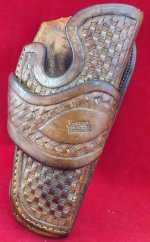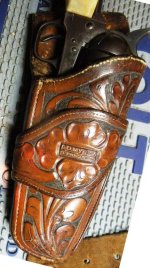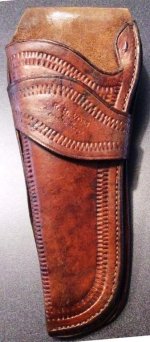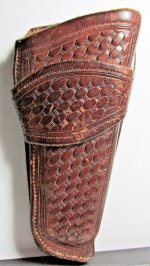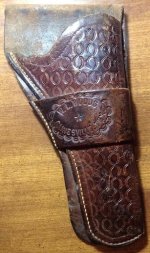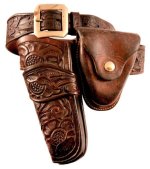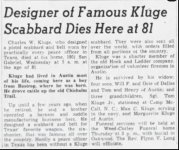I just found something online that may help a little more in determining who was the first designer of the Brill holster. It has been said by some that Charles Kluge was just a superbly talented saddle maker, and how do we know for sure he made holsters. Well I found this:
Larry
https://www.austintexas.gov/edims/document.cfm?id=199534
Judges' Hill District History
Compiled by Phoebe Allen
Page 13
William and Anna Kluge, originally from Germany, owned all of Outlot 15 (just north of 16) and built their brick home facing Pearl Street about 1880. Their sons Henry T. and Charles W. Kluge established a saddle and harness business on East Sixth Street in 1886. In the 1890s Charles built a charming one-story Victorian house with a wraparound porch and gabled attic at 1801 San Gabriel; it has since been moved to Heritage Square on Bee Caves Road.
Page 31
c1880 WILLIAM KLUGE HOMESITE, 1802 Pearl (razed). Outlot 15.
William and Anna Kluge, originally from Germany, built a brick home about 1880. City Lot
Register for 1890 indicates that Anna owned all of Outlot 15, with a value of $3500. The Kluges had a saloon and restaurant on Congress. The couple had three children: Henry, Charles, and Mary. By 1881, Anna lived on Pearl 'between Chestnut and Magnolia' with two of her sons, Charles and Henry. The Kluges occupied the one-story house with attic floor for several years. The wood frame Victorian home had a front porch.
Their son Henry Theodor Kluge (1859-1939), a bookkeeper, and his wife Mattie Cooper McDannell Kluge (1861-1924) are listed at 1810 Pearl (razed) in the city directories from 1905- 37. Their frame home also had a partial porch with Victorian trim. Henry first went to school in Austin then finished primary, secondary and Heidleberg University in Germany. He and his brother Charles owned the Kluge Brothers Leather & Harness Shop on Congress & 5th. Charles was the artist in leather carving; he made and decorated saddles, chaps, boots,
holsters and belts. Henry managed the business and raised fine saddle horses. [see 1897 Charles Kluge House]
1802 Pearl was sold to Angeline Townsend's daughter, Pauline Townsend Culbertson (3 Dec 1854-1920?), for herself and her two children: Angeline Louise Culbertson (1889-1996) and William James 'Jamie' Culbertson Jr. (1892-?). Culbertson was listed at 1802 Pearl in the 1909- 1920 City Directories.
Page 36
1897 CHARLES KLUGE HOUSE, 1801 San Gabriel (moved). Outlot 15.
Brothers Henry T. and Charles W. Kluge established a saddle and harness business on East
Sixth Street in 1886. In the 1890s they acquired land from their mother, who had lived on the opposite side of the same block at 1802 Pearl. Charles built this charming one-story Victorian house with a wraparound porch and gabled attic; it has since been moved to Heritage Square on Bee Caves Road. The L-plan house had a basement. [see William Kluge House]
Henry Theodor Kluge (1859-1939) & his wife Mattie Cooper McDannell Kluge (1861- 1924) are listed at 1810 Pearl in the city directories from 1905 through 1937. Henry first went to school in Austin then finished primary, secondary and Heidleberg University in Germany. He and his brother Charles owned the Kluge Brothers Leather & Harness Shop on Congress & 5th. Charles was the artist in leather carving; he made and decorated saddles, chaps, boots,
holsters and belts. Henry managed the business and raised fine saddle horses.




